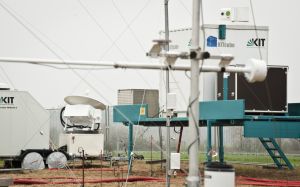Clouds appear to be large structures, but consist of ten thousands of water droplets and ice particles of variable size and shape. The Federal Ministry of Education and Research (BMBF) funds the research project “Cloud and Precipitation Processes in the Climate System – HD(CP)2” with a total amount of EUR 11 million. One of the project partners is Karlsruhe Institute of Technology (KIT). The project studies the spatial structure of clouds and their particle composition. It is aimed at improving the understanding of cloud and precipitation formation and, hence, weather and climate models.
The abbreviation HD(CP)2 stands for “High Definition Clouds & Precipitation for Advancing Climate Prediction“. 120 researchers from 17 institutes are involved in the project. From April to July 2013, a measurement campaign called “HOPE” will be performed on an area measuring 10 x 10 km2 around Forschungszentrum Jülich. There, remote sensing instruments will determine spatial temperature, humidity, and cloud fields up to about 10 km height with tilting lidar and radar devices and a number of ground sensors measuring temperature, humidity, and solar irradiation. More than 20 of these remote sensing systems will be coordinated and operated all around the clock in order to capture as many weather situations as possible. This will result in the most complete conception of the formation and development of clouds that has been obtained so far. The complex ground-based measurements will be complemented by a total of 300 radiosonde ascents.
The Institute of Energy and Climate Research of Forschungszentrum Jülich will host scientists from the Universities of Cologne, Bonn, Hohenheim, Berlin, Leipzig, and Munich, the Max Planck Institute for Meteorology in Hamburg, the Institute of Meteorology and Climate Research of Karlsruhe Institute of Technology (KIT), and the Leibniz Institute for Troposphere Research in Leipzig. Other national and international partners will join the experiment to complement and refine experimental measurements of the complex cloud system. These measurements will be accompanied by weather and climate calculations using latest model generations on the fastest high-performance computers available in Germany. The data obtained under HOPE will be used to assess the accuracy of the models. Comparison between model and reality will lead to model improvement. HOPE will also be a prototype of future European networks of fields for weather and climate measurements. The project is managed by a team of experts from Bonn, Hamburg, Hohenheim, Karlsruhe, and Leipzig.
The Troposphere Research Division of the KIT Institute of Meteorology and Climate Research (IMK-TRO) will apply the “KITcube” for atmosphere monitoring. This instrument consists of lidar and radar devices as well as of weather probes. IMK-TRO scientists will measure the complete process chain from evaporation on the ground to development with time and spatial distribution of humidity in the atmosphere to cloud and precipitation formation.
More information: http://hdcp2.zmaw.de/HOPE.2306.0.html
The KIT Climate and Environment Center develops strategies and technologies to secure the natural bases of life. For this purpose, 660 employees of 32 institutes produce fundamental and application-oriented knowledge relating to climate and environmental change. It is not only aimed at eliminating the causes of environmental problems, but increasingly at adapting to changed conditions.
In close partnership with society, KIT develops solutions for urgent challenges – from climate change, energy transition and sustainable use of natural resources to artificial intelligence, sovereignty and an aging population. As The University in the Helmholtz Association, KIT unites scientific excellence from insight to application-driven research under one roof – and is thus in a unique position to drive this transformation. As a University of Excellence, KIT offers its more than 10,000 employees and 22,800 students outstanding opportunities to shape a sustainable and resilient future. KIT – Science for Impact.

